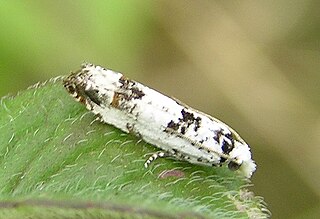
Eucosma is a very large genus of moths belonging to the family Tortricidae. Some taxonomies place a number of species in the genus Eucopina. The genus has a Holarctic and Indomalayan distribution. Even in well-studied Europe and North America, new species are still regularly discovered. There are at least 670 described species in Eucosma worldwide.

Eucosma campoliliana is a moth of the family Tortricidae. It is found in Europe, China, Japan and Russia.
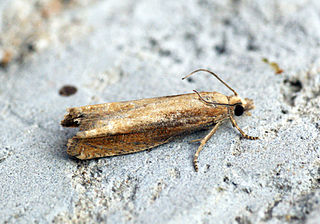
Eucosma obumbratana is a moth of the family Tortricidae. It is found in Europe, China (Jilin), Russia and Kazakhstan.

The Eucosmini are a tribe of tortrix moths.
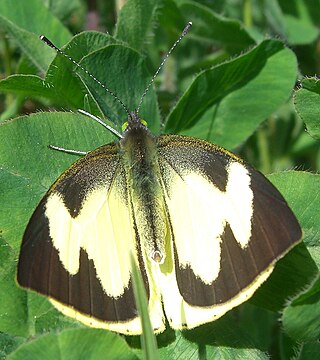
Leptophobia is a Neotropical genus of butterflies in the family Pieridae.

Leptophobia eleone, the silky wanderer or eleone white, is a butterfly in the family Pieridae. It is found from Colombia to Bolivia. The habitat consists of cloud forests.

Leptophobia caesia, the bluish white, is a butterfly in the family Pieridae. The species was first described by Hippolyte Lucas in 1852. It is found from Mexico to Ecuador. This butterfly inhabits various environments, including tropical and subtropical forests, and is often seen near rivers and streams. Leptophobia caesia is known for its delicate, pale blue to white wings, which provide effective camouflage against predators. Its presence contributes to the biodiversity of the regions it inhabits, and it plays a role in pollination, thus supporting the local ecosystems.
Leptophobia cinerea, the cinerea white, is a butterfly in the family Pieridae. It is found from Ecuador to Bolivia.
Leptophobia diaguita is a butterfly in the family Pieridae first described by Peter Jörgensen in 1916. It is found in Argentina, Peru and Ecuador.
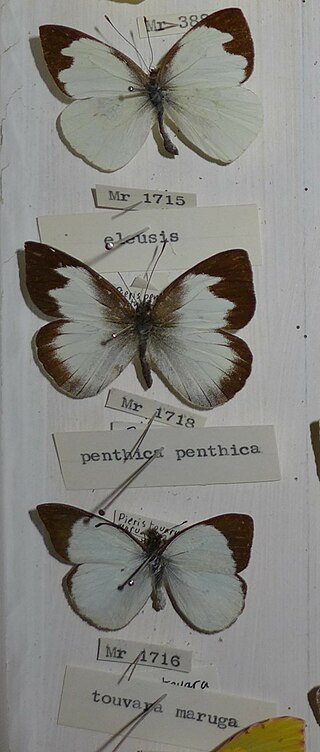
Leptophobia eleusis, the Eleusis white, is a butterfly in the family Pieridae. The species was first described by Hippolyte Lucas in 1852. It is found from Venezuela to Bolivia.
Leptophobia forsteri is a butterfly in the family Pieridae. It is found in Peru, Colombia and Venezuela.

Leptophobia penthica, the penthica white, is a butterfly in the family Pieridae. It is found in Colombia, Bolivia and Venezuela.
Leptophobia gonzaga, the Gonzaga white, is a butterfly in the family Pieridae. It is found in Colombia and Ecuador.
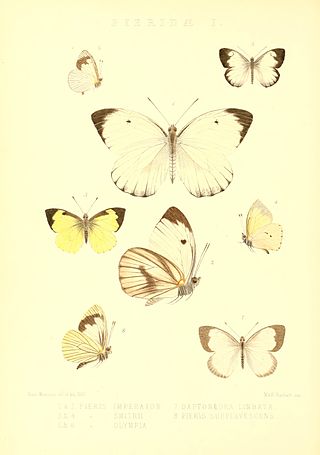
Leptophobia helena, the Helena white, is a butterfly in the family Pieridae. The species was first described by Hippolyte Lucas in 1852. It is found in Colombia, Bolivia, Peru and Ecuador.
Leptophobia micaia is a butterfly in the family Pieridae. It is found in Colombia.

Leptophobia olympia, the Olympia white, is a butterfly in the family Pieridae. It is found in Peru, Ecuador, Venezuela and Colombia.
Leptophobia philoma, the philoma white, is a butterfly in the family Pieridae. It is found in Peru, Ecuador and Bolivia.

Leptophobia pinara, the Pinara white, is a butterfly in the family Pieridae. It is found in Peru, Ecuador and Colombia.

Leptophobia tovaria, the tovaria white, is a butterfly in the family Pieridae. It is found in Peru, Venezuela, Ecuador and Colombia.

Eucosma dorsisignatana, the triangle-backed eucosma, is a species of moth of the family Tortricidae. It is found in North America, where it has been recorded from Nova Scotia to Florida, west to Texas and north to Manitoba.








